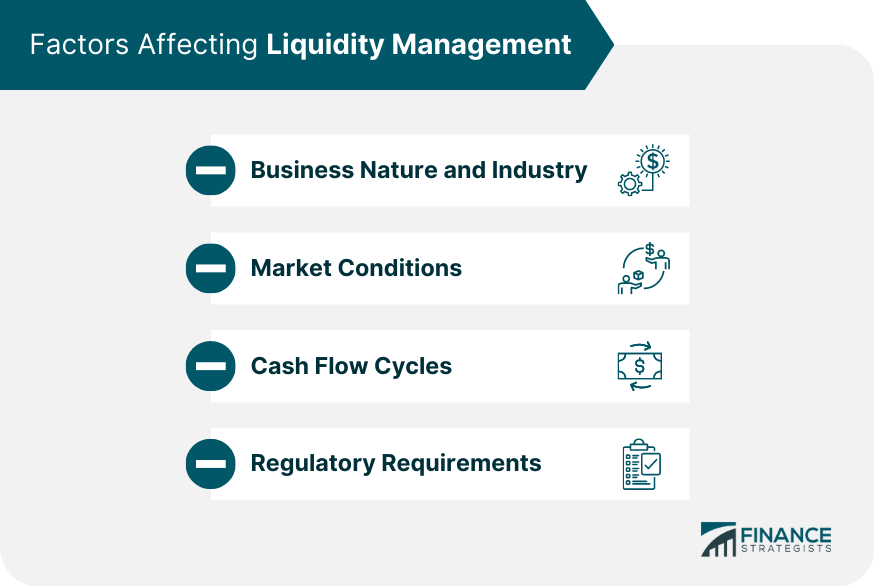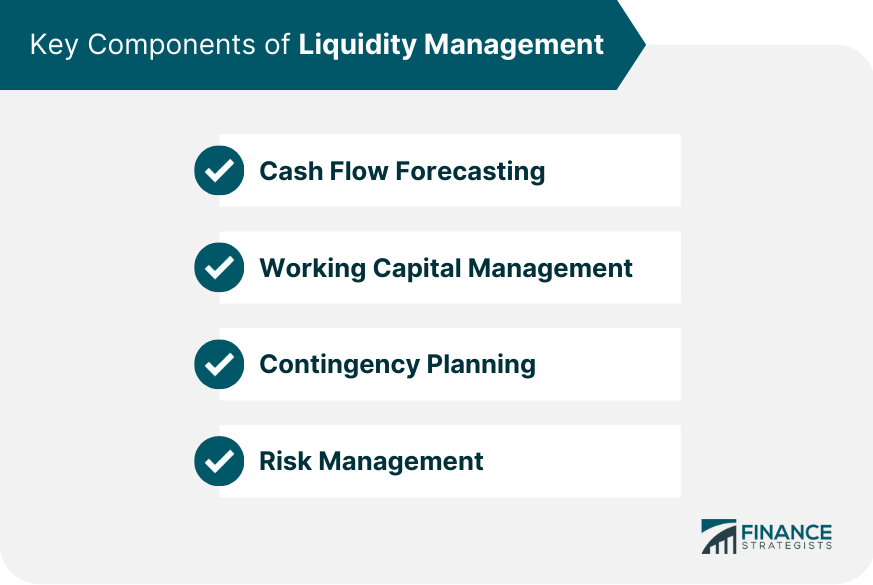Liquidity management refers to ensuring that a company or an individual has sufficient cash to meet their short-term financial obligations. Effective liquidity management is essential for maintaining financial stability, avoiding potential insolvency or bankruptcy, and preserving a strong credit rating. The primary objectives of liquidity management include: Ensuring the availability of cash to meet financial obligations on time. Minimizing the cost of holding idle cash or liquid assets. Optimizing the use of available cash resources. Managing liquidity risks and uncertainties. The nature of a business and its industry can significantly impact liquidity management. For example, seasonal businesses or companies in cyclical industries may require more robust liquidity management strategies to address fluctuations in cash flows. Market conditions, such as economic cycles, interest rate environments, and geopolitical events, can influence liquidity management by affecting the availability and cost of credit and the demand for products and services. Cash flow cycles, which represent the time it takes for a company to convert its investments in inventory and other resources back into cash, can also affect liquidity management. Companies with longer cash conversion cycles may require more extensive liquidity management measures to ensure adequate cash availability. Regulatory requirements, such as capital adequacy and liquidity ratios imposed by financial regulators, can also influence liquidity management strategies and practices, particularly for financial institutions. Short-term cash flow forecasting involves projecting cash inflows and outflows over a period of days, weeks, or months. This helps companies plan for their immediate needs and manage day-to-day cash flows effectively. Medium to long-term cash flow forecasting focuses on projecting cash flows over a period of several months to years. This allows companies to plan for significant capital expenditures, debt repayments, and other strategic initiatives that may impact their liquidity position. Effectively managing accounts receivable involves implementing policies and processes to ensure the timely collection of payments from customers, reducing the likelihood of bad debts and improving cash flow. Managing accounts payable involves negotiating favorable payment terms with suppliers and making timely payments to maintain positive vendor relationships and take advantage of early payment discounts when available. Inventory management entails optimizing inventory levels to minimize carrying costs and avoid stockouts while ensuring sufficient supply to meet customer demand. Creating and maintaining emergency funds can help companies address unforeseen liquidity needs and mitigate the impact of unexpected cash flow disruptions. Establishing lines of credit with financial institutions can provide companies with a flexible source of funds to address temporary liquidity shortfalls or finance growth opportunities. Effective liquidity management also involves identifying and mitigating various risks that can impact a company's cash position, such as interest rate, foreign exchange, and credit risk. Zero balance accounts are bank accounts that automatically transfer funds to or from a master account to maintain a zero balance. This allows companies to consolidate cash balances across multiple accounts, improving cash management efficiency. Notional pooling is a cash management technique that combines multiple accounts' balances for interest calculation purposes without physically transferring funds between accounts. This enables companies to optimize interest income and minimize borrowing costs while maintaining separate accounts for different business units or legal entities. Money market funds are short-term investment vehicles that invest in low-risk, highly liquid securities such as treasury bills and commercial paper. These funds can provide companies with a relatively safe and accessible option for investing excess cash. Bank deposits, such as savings accounts or certificates of deposit (CDs), can also serve as short-term investment options for companies seeking to earn interest on idle cash balances while maintaining liquidity. Treasury bills are short-term debt securities issued by governments with maturities ranging from a few days to one year. These instruments offer low-risk investment opportunities for companies looking to park excess cash while preserving capital and liquidity. Electronic funds transfer systems enable companies to make and receive payments electronically, reducing transaction times and improving cash flow management efficiency. Lockbox services provided by banks involve collecting and processing customer payments on behalf of a company, accelerating the collection of receivables and enhancing cash flow visibility. Treasury management systems are software applications designed to automate and streamline various aspects of liquidity management, including cash flow forecasting, working capital management, and risk management. APIs allow companies to integrate their treasury management systems with other financial systems and data sources, facilitating real-time access to cash balances and transaction data across multiple accounts and financial institutions. Real-time data and analytics tools enable companies to monitor and analyze their cash positions and liquidity risks more effectively, supporting more informed decision-making and proactive liquidity management. Basel III is a set of international banking regulations aimed at enhancing the global financial system's stability. The Liquidity Coverage Ratio (LCR) is a key component of Basel III that requires banks to maintain sufficient high-quality liquid assets to cover their net cash outflows over a 30-day stress period. The Net Stable Funding Ratio (NSFR) is another Basel III requirement designed to promote the stability of banks' funding structures by ensuring they maintain a minimum amount of stable funding relative to the liquidity characteristics of their assets. In addition to international regulations, companies must also consider local regulatory requirements related to liquidity management, such as capital adequacy ratios or reserve requirements imposed by central banks and financial regulators. Banks and financial institutions offer a range of cash management services to help companies optimize their liquidity management, including cash concentration and pooling solutions, payment and collection services, and short-term investment products. Banks and financial institutions can also provide credit facilities and lines of credit to support companies' liquidity needs, offering flexible financing options to address temporary cash shortfalls or fund growth initiatives. For companies operating across multiple countries, banks and financial institutions can offer international liquidity management solutions, such as global cash pooling and multicurrency accounts, to help manage cash flows and liquidity risks across different currencies and jurisdictions. Effective liquidity management is critical for maintaining financial stability and ensuring the long-term success of companies. By proactively managing their cash flows and liquidity risks, companies can better navigate economic uncertainties, capitalize on growth opportunities, and minimize the likelihood of financial distress. Implementing robust liquidity management strategies and leveraging available tools and resources, such as cash pooling, short-term investment instruments, and treasury management systems, can help companies optimize their liquidity positions and achieve their financial objectives. Additionally, staying informed about market trends, regulatory changes, and technological innovations is essential for adapting to the dynamic financial landscape and maintaining a competitive edge in liquidity management.What Is Liquidity Management?
Factors Affecting Liquidity Management
Business Nature and Industry
Market Conditions
Cash Flow Cycles
Regulatory Requirements

Key Components of Liquidity Management
Cash Flow Forecasting
Short-Term Cash Flow Forecasting
Medium to Long-Term Cash Flow Forecasting
Working Capital Management
Accounts Receivable Management
Accounts Payable Management
Inventory Management
Contingency Planning
Emergency Funds
Lines of Credit
Risk Management

Liquidity Management Strategies and Tools
Cash Concentration and Pooling
Zero Balance Accounts (ZBAs)
Notional Pooling
Short-Term Investment Instruments
Money Market Funds
Bank Deposits
Treasury Bills
Effective Payment and Collection Systems
Electronic Funds Transfer (EFT)
Lockbox Services
Use of Technology for Liquidity Management
Treasury Management Systems (TMS)
Application Programming Interfaces (APIs)
Real-Time Data and Analytics
Regulatory and Compliance Considerations in Liquidity Management
Basel III and Liquidity Coverage Ratio (LCR)
Net Stable Funding Ratio (NSFR)
Local Regulatory Requirements
Role of Banks and Financial Institutions in Liquidity Management
Cash Management Services
Credit Facilities and Lines of Credit
International Liquidity Management Solutions
Conclusion
Liquidity Management FAQs
Liquidity management is the process of ensuring that a company has sufficient cash and other liquid assets to meet its short-term financial obligations while minimizing the risk of financial distress.
Liquidity management is important because it allows companies to manage their cash flow effectively and avoid financial problems such as bankruptcy, defaulting on loans, or missing payments to suppliers.
Some common liquidity management strategies include maintaining a cash reserve, managing accounts receivable and payable, using short-term financing options such as lines of credit or factoring, and investing excess cash in short-term, low-risk securities.
Companies can improve their liquidity management by closely monitoring their cash flow and forecasting their cash needs, negotiating favorable payment terms with suppliers, implementing efficient accounts receivable and payable processes, and maintaining a diversified portfolio of short-term investments.
Poor liquidity management can result in a number of risks, including a lack of cash to pay bills or meet obligations, missed growth opportunities due to insufficient funds, reduced creditworthiness and higher borrowing costs, and potential legal or regulatory problems.
True Tamplin is a published author, public speaker, CEO of UpDigital, and founder of Finance Strategists.
True is a Certified Educator in Personal Finance (CEPF®), author of The Handy Financial Ratios Guide, a member of the Society for Advancing Business Editing and Writing, contributes to his financial education site, Finance Strategists, and has spoken to various financial communities such as the CFA Institute, as well as university students like his Alma mater, Biola University, where he received a bachelor of science in business and data analytics.
To learn more about True, visit his personal website or view his author profiles on Amazon, Nasdaq and Forbes.















